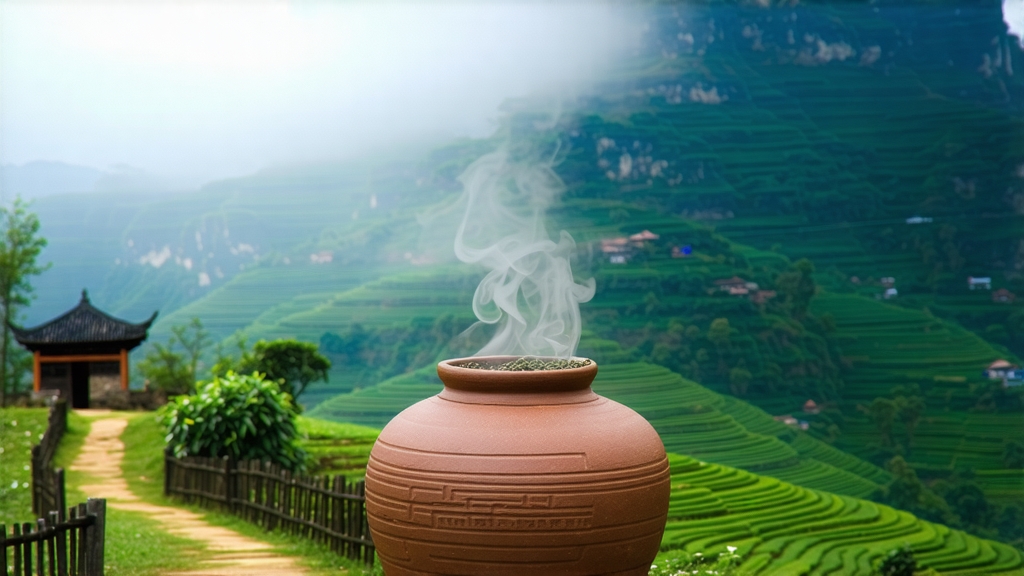
Liu Bao cha, literally “Six Forts tea,” is the quiet genius of China’s dark-tea family. While Pu-erh has conquered auction headlines and tea-shop shelves, Liu Bao has spent four centuries maturing in the humid mountain cellars of Guangxi Province, slowly turning leaf into liquid history. To the international palate it remains an undiscovered country: a tea that smells of damp earth, rainforest bark and, mysteriously, fresh betel nut, yet finishes with a clean, malty sweetness that lingers like old velvet. This article invites you to travel the trade routes, fermentation rooms and clay jars that shape Liu Bao, and to learn how to coax its quiet power into your own teapot.
-
From Frontier Garrison to Global Cup
The name Liu Bao refers to the six defensive forts established during the Ming dynasty along the upper reaches of the Liu Jiang River in Wuzhou prefecture. Soldiers stationed there received coarse tea as part of their rations; the humid garrison storehouses accidentally initiated the first slow post-fermentation. By the Qing Qianlong era (1736-1795) the tea was being compressed into 40 kg bamboo baskets, strapped to mules, and marched 1,200 km to Guangzhou where it boarded clipper ships bound for Southeast Asia. In Kuala Lumpur, Penang and Singapore, coolies drank it to prevent malaria and dysentery; tin-mine owners valued it as a currency to pay workers. Thus Liu Bao became one of the earliest Chinese teas to develop an overseas identity long before the word “export” was fashionable. -
Terroir: Where Subtropical Mist Meets Red Clay
The core micro-region lies between 23° and 24° north latitude, where the Dayao and Liubao mountains rise 800-1,200 m above sea level. Annual rainfall exceeds 1,500 mm, fog drapes the valleys 220 days a year, and the soil is lateritic—rich in iron oxide and organic leaf litter. The indigenous cultivar is the medium-leaf “Yuntai Da Ye” (Cloud Terrace Big Leaf), a genetic cousin of Yunnan’s Da Ye Zhong but acclimatized to Guangxi’s shorter winters. The leaf is naturally higher in pectin and polyphenol oxidase, two biochemical prerequisites for the intense microbial fermentation that follows. -
Craft: The Bamboo-Basket Symphony
Liu Bao’s processing is a six-act play performed between March and October.
Act I – Pluck: one bud with three to four leaves, when the fog lifts at 7 a.m.
Act II – Wilting: 4-6 hours on bamboo mats inside ventilated sheds; moisture drops to 65 %.
Act III – Kill-Green: wok firing at 180 °C for three minutes halts oxidation but keeps inner leaf enzymes alive.
Act IV – Rolling: 40 minutes of machine twisting ruptures 60 % of cell walls without breaking leaf surface.
Act V – Pile-Fermentation: the signature step. Leaves are piled 70 cm high inside double-walled bamboo baskets lined with gunny sacks. A natural inoculum—dominated by Aspergillus niger, Blastobotrys adeninivorans and Lactobacillus plantarum—arrives on the bamboo itself. Workers spray mist every 12 hours and monitor internal temperature (kept below 55 °C). After 25-30 days the leaf turns chestnut-brown and develops the famous “betel-nut” aroma (β-ionone and 1,2,3-trimethoxybenzene peak at this stage).
Act VI – Drying & Aging: baskets are transferred to loft-like warehouses where charcoal fires beneath wire mesh reduce moisture to 12 % over three days. The semi-dry tea is then moved to underground caves (constant 25 °C, 80 % RH) for a minimum of twelve months; premium lots rest for fifteen years or more. During aging the tea is turned every June and December so every leaf breathes equally.
- Grades & Shapes
Traditional baskets: 40 kg “Lang” baskets woven from river bamboo; the tight weave allows 5 % oxygen ingress per year—ideal for slow aging.
Modern bricks: 250 g or 1 kg rectangular bricks pressed at 15 bar, designed for urban storage.
Loose “San Cha”: small